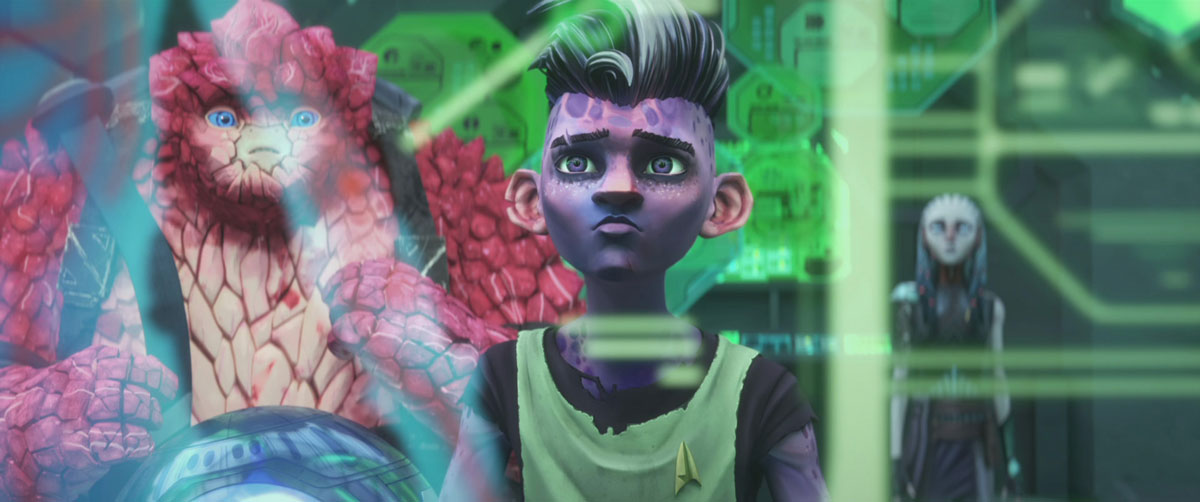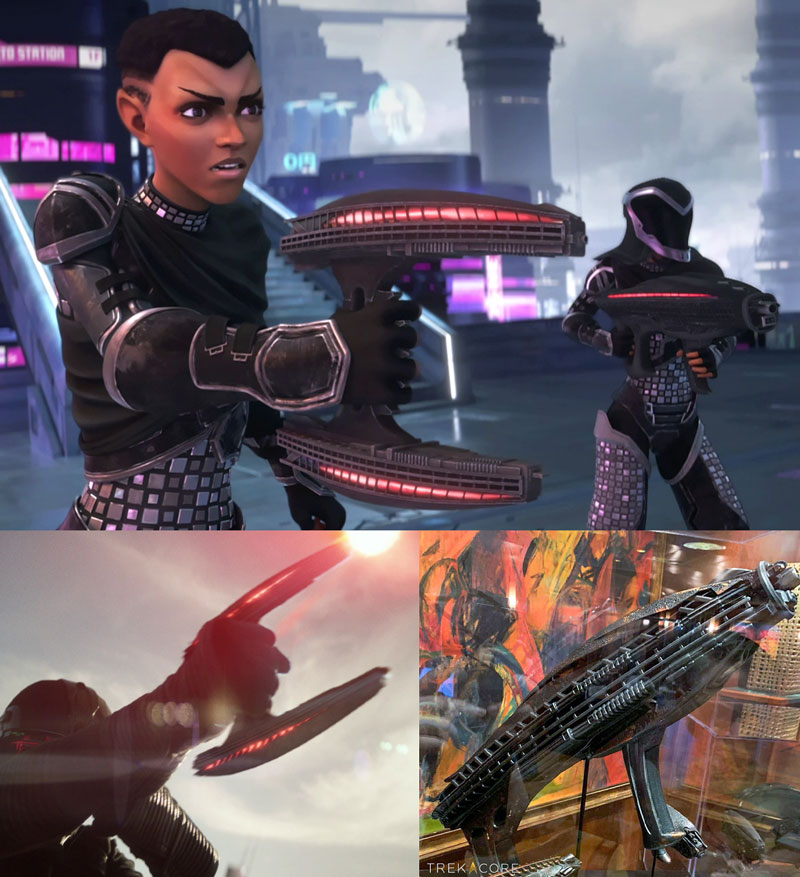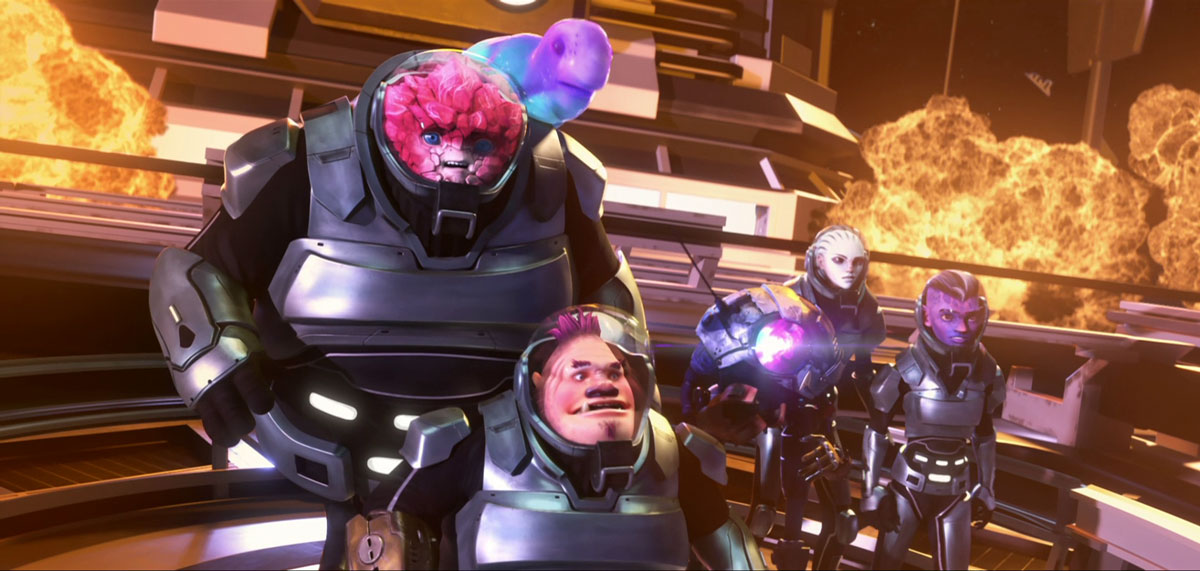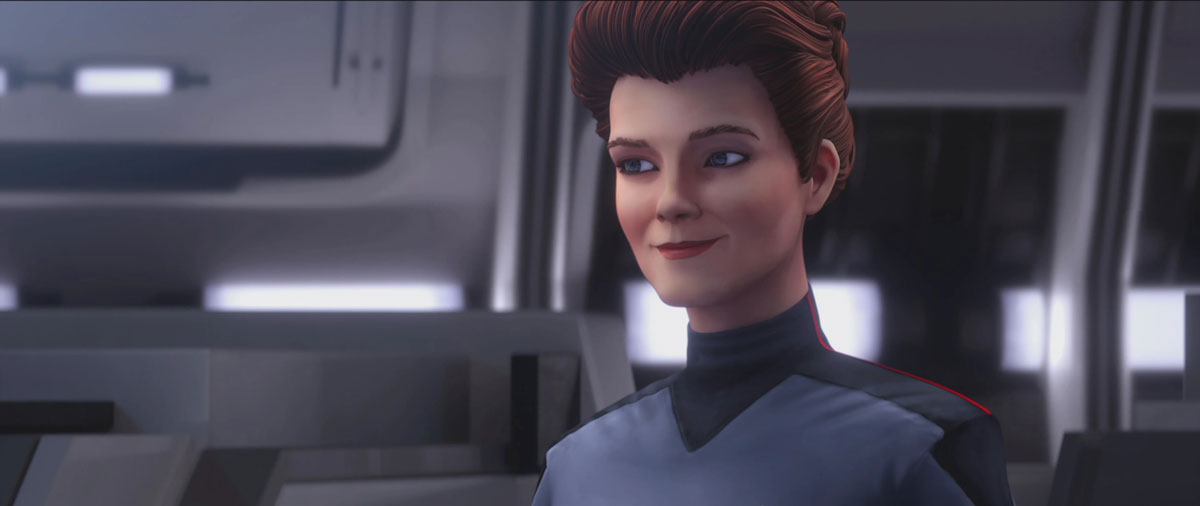We’re at the midpoint of Star Trek: Prodigy’s fall run, bringing us just five weeks away from the Season 1 finale — and today we’re bringing you even more behind-the-scenes insight about the animated series in another wide-ranging discussion.
In the second half of a two-part interview with Prodigy co-executive producer and Season 2 co-head writer Aaron Waltke (check out Part 1 here!), we learn how Dal’s just-revealed backstory came to be, how the series’ timeline is marching towards established canon, and much more.

TREKCORE: Finally revealed in “Masquerade,” Dal’s history is very interesting and complex — how was it decided that he’d be an Augment?
AARON WALTKE: It is complex, because I think if you zoom out 30,000 feet, the first ten episodes were learning about the idealized version of Star Trek, of Starfleet and the Federation, what it represents, its ideals, its beliefs. And I think the second ten are very much diving into the complexities of Star Trek, like: how do you put those beliefs or ideals or rules into practice in a way that still upholds the basic tenets of what Starfleet, or what Star Trek is?
I think true to our nature, we didn’t wanna shy away from some of the things that we felt were still maybe a little bit unfair. Like, for instance, how augments are treated in the 24th century. We didn’t just want Starfleet to have an effect on our kids, but we wanted the journey of our Prodigy crew to have an effect on Starfleet. And one way that we could do that was by addressing what I would say is one of those dangling unanswered questions that could be explored deeper.
TREKCORE: Dal steps into the bioscan in “Asylum,” and the lights flash. They want him to report to Starfleet, probably as a fugitive.
WALTKE: Yeah. We’ve seen in Deep Space Nine, how Augments are treated — specifically in “Doctor Bashir, I Presume” and “Statistical Probabilities” — where they’re kind of treated as second-class citizens, and they outright state it’s because the authorities are afraid. You might get a Julian Bashir… but you might also get another Khan.
But I think there’s how you kind of skew that versus people that, you know, maybe didn’t ask to be genetically augmented. You see a little bit of progress with that with Julian Bashir, but even then, his dad was sent to prison, right? So there’s this sort of thorniness that I think Star Trek, and our writers, just can’t help but return to and further explore and question and wonder, does it have to be this way, or are there things yet unresolved?
TREKCORE: The Romulan soldiers chasing the kids in “Masquerade” carry weapons right out of Star Trek: Picard’s first season.
How close are is the Prodigy writing team following where things are in comparison to the Picard backstory — the destruction of Romulus, the devastation on Mars, the ban on synthetics, all that stuff?
WALTKE: You hit the nail right on the head, because there are things coming up in canon that we cannot ignore. You know we’re at a place in the timeline canonically when there are rogue factions within the Romulan Tal Shiar that have a mandate to find a way to hijack Starfleet systems and turn their AI against themselves.
Whether through their secret channels, or monitoring subspace channels or transmissions, when they hear about the Living Construct, that there’s a device that can turn Starfleet against itself, they are going to be very interested in that technology.
So we have some visual cues to that — this sort of rogue faction has some of the gear from Picard, just to imply that yeah, it’s happening, and it’s going to happen, and this is the first kind of hint to that. And even without Dal’s command codes, who knows what kind of information they were able to garner from scanning the Protostar — and and who knows how that will tie into the events of what eventually happens in 2385?
TREKCORE: A lot of big things happened in these last five episodes — Murf’s change, Dal’s backstory, Gwyn’s memories recovered, and Admiral Janeway meeting the crew face to face. How does that pacing work in the writer’s room, deciding when to drop certain bombshells along the way? Can we expect that same rapid pace in the last five episodes?
WALTKE: The short answer? Yes. I think especially when you’re dealing with a 20-episode story line, and you’re kind of building up to a climax there are some things that we kind of push off, but there’s sort of an adage in screenwriting that we always believe in: if you have a good idea, use it now, don’t save it for later.
Do it now and come up with something better in the next episodes. For instance, with Gwyn’s memory loss, there are shows out there that would spend 10 episodes of her slowly piecing together what the audience already knows. And all of us said, “We don’t want to do that.”
It served its purpose in so far as it inadvertently allowed them to see the destructive capacity that they were carrying and kicking off the inciting incident of these next 20 episodes. But we thought there was much more rich character work and storytelling to be told now that they’re all on the same page, how do we unwind the cards that have been stacked against our crew? The best thing you can do, I think, with any story, is paint your characters into corner after corner, because then it becomes all the more thrilling.
You don’t at first know how they’re going to get out of it. Then when you actually sit down and try to do it, it becomes all the more clever and unique. So the short answer is, you will see things ramp up. We have a little bit of a breather before the final kaboom.
TREKCORE: The season finale is called “Supernova,” which happens to be the same name of the recently-released Star Trek: Prodigy video game. Is there a connection there, or are the shared titles just a coincidence?
WALTKE: Well, video game takes place between “A Moral Star, Part 2” and “Asylum,” so it’s not a retelling of the events of the game — but thematically, you’ll find that there’s some spiritual overlap
TREKCORE: Will some of the lore from the video game make its way into the show going into the future?
WALTKE: Yes. We were in direct communication with the team that wrote the game, and they had Lisa Schultz Boyd, one of our staff writers, to kind of oversee some of that as well. But it’s another instance where, you know, it wasn’t just made in a vacuum. We were very much all talking together to see if we could make this a fun kind of ancillary element for people that couldn’t get enough Prodigy to find out even more.
Because for me, I loved that, whether it’s the video games or the books or whatever. I couldn’t get enough of that. I want to know more. In this case, we were in direct communication with everybody. Just saying like, here’s some stuff that we talked about in the writer’s room that ties directly into stuff that comes in the show that you can definitely expect to see in some way.
TREKCORE: Speaking of tie-ins, the “Janeway Logs” you’ve been writing for Instagram have been giving some interesting information about the show, hinting towards Chakotay’s original mission on the Protostar, and that B’Elanna Torres designed the Dauntless. Will we learn more about those things in the show?
WALTKE: Yes! What’s fun about the logs and the show is they are meant to sort of inform each other and be sort of a cohesive story, and so there’s going to be some details in the logs that will fill in and make certain things in the show make sense, and vice versa.
And from the beginning in the writer’s room, that was one of the first questions we answered. Week 1 is like, why was the Protostar in the Delta Quadrant. And the answer we all agreed on as a writer’s room from the beginning was, well, they’re going back to basically clean up the roughshod voyage that was like a bowling ball in a China shop Voyager kind of shot through, and I think even Janeway herself will be the first to say that there are things I would like to go back to and there’s more work to be done in the Delta Quadrant.
Which is why I think when Chakotay wanted to go, it made total sense. And she was for it even if she wasn’t thrilled to have her first officer suddenly have to go off by himself. I think the reason we chose Chakotay and B’Elanna Torres in the logs, as mentioned, is even though they’re no longer Maquis, I think they certainly understand more than anyone, that there are two sides to any Federation first contact, and you have to take responsibility for your actions. So, that was sort of the backstory there.
TREKCORE: Will Hologram Janeway get to have her own character arc, like the Protostar kids, as the show moves forward from here?
WALTKE: For me, the joy of a hologram character in all of Star Trek is them growing beyond their programming and doing sort of the unexpected, just as any humanoid would. There’s going to be some things that happen, and some choices that are made by Hologram Janeway — both good and bad — that will surprise you. She will have a little bit of growth and an arc, and I can’t wait for everybody to see it because these next five episodes are pretty big for her.
TREKCORE: We know that Season 2 — the next 20 episodes to follow this fall run — are well into production and moving to post-production at this point. Are you and the team looking beyond that yet, into storytelling for a potential third season?
WALTKE: Oh, yes, constantly. Yes. I think the Hagemans and I are such that, you know, we would love for this show to go seven seasons — and a movie beyond. We’re always thinking of ways to tell the story that feels satisfactory, but there’s always a new horizon, right?
And as far as where that horizon goes, yes, we certainly talked about it. But you know, we’ll have to see about Season 3.
This interview has been condensed and edited for clarity.
![]()
Star Trek: Prodigy will return with “Preludes” on Thursday, December 1 on Paramount+ in the United States, and on December 2 in Latin America, Australia, Italy and the U.K. The series will arrive in France, Germany, Switzerland, and Austria in December.



